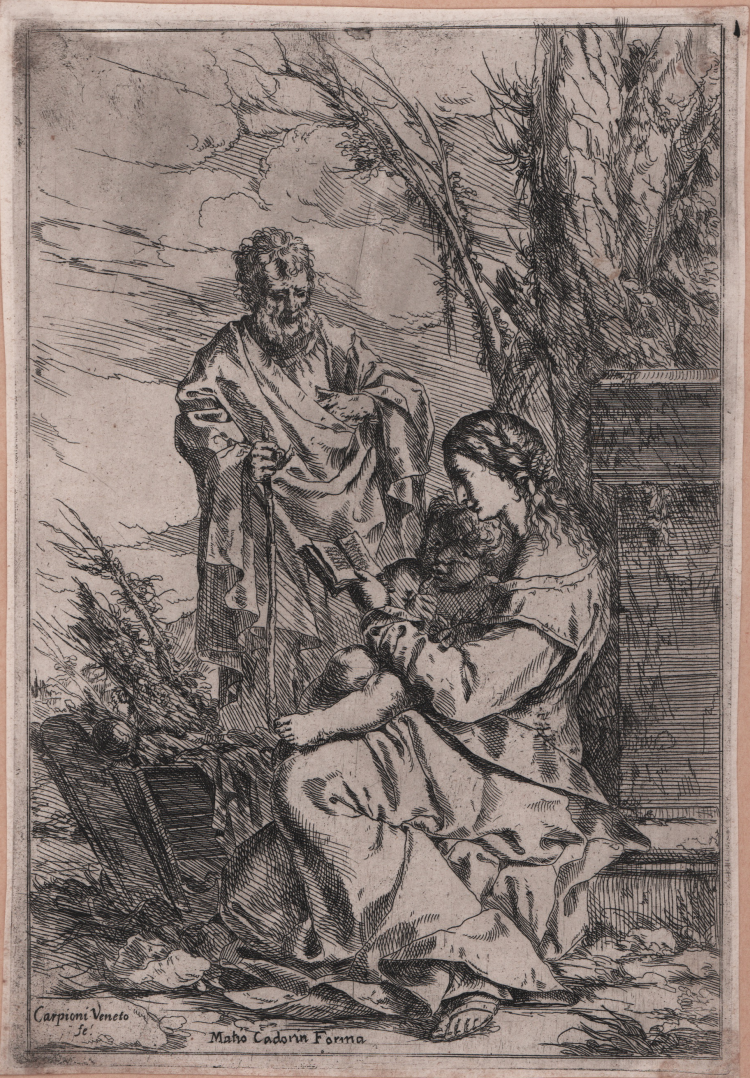




| Reference: | S7236 |
| Author | Giulio CARPIONI |
| Year: | 1650 |
| Measures: | 147 x 215 mm |



| Reference: | S7236 |
| Author | Giulio CARPIONI |
| Year: | 1650 |
| Measures: | 147 x 215 mm |
Etching, 1650, signed on plate at lower right.
Example in the second state of three, the address of the editor Matteo Cadorin added at bottom centre.
Exceptional proof, characterised by the plate-tone typcal of the first impressions, on contemporary laid paper, unknown watermark, small margins, in very good conditions.
The plate has a scratch, whose effects are visible at Saint Joseph's right, which is typical of all the proofs belonging to the first and second states.
Giulio Carpioni was af follower of Parmigianino and afterwards of Ottino, whose influence led him to know Caravaggio, Carpioni was one of the most interesting artists of the XVII century neo-Venetian Classicism in Northern Italy. He put together various experiences coming from different Regions in Italy (Realism from Lombardy, classicims from Bologna and Poussin) to reach his peculiar and particular style among the most interesting in the contemporary Venetian painting; we have evidences of it in his Bacchanalia and in the landscapes with Nynphs and Satyrs.
These subjects can be found also in some etching Carpioni realized; he was really fond of this particular technique, although he realized just a few pieces. His etchings, in any case, are extremely rare and they all reveal the influence Poussin had on his classicism and also the interest in Pietro Testa and Giovanni B. Castiglione.
Carpioni is mainly famous for his paintings; his activity as etcher can be considered a sort of experimentation in his young age.
Bibliographic references
Bartsch / Le Peintre graveur (XX.181.5); Calabi 1921 / The etchings of Giulio Carpione (3.II); Mazzoli 2008 / Giulio Carpioni incisore tra classicismo e barocco (5)
Giulio CARPIONI (Vicenza 1613 – 1679)
|
Follower of Parmigianino and afterwards of Ottino, whose influence led him to know Caravaggio, Carpioni was one of the most interesting artists of the XVII century neo-Venetian Classicism in Northern Italy. He put together various experiences coming from different Regions in Italy (Realism from Lombardy, classicims from Bologna and Poussin) to reach his peculiar and particular style among the most interesting in the contemporary Venetian painting; we have evidences of it in his Bacchanalia and in the landscapes with Nynphs and Satyrs.
These subjects can be found also in some etching Carpioni realized; he was really fond of this particular technique, although he realized just a few pieces. His etchings, in any case, are extremely rare and they all reveal the influence Poussin had on his classicism and also the interest in Pietro Testa and Giovanni B. Castiglione.
Caprioni is mainly famous for his paintings; his activity as etcher can be considered a sort of experimentation in his young age.
|
Giulio CARPIONI (Vicenza 1613 – 1679)
|
Follower of Parmigianino and afterwards of Ottino, whose influence led him to know Caravaggio, Carpioni was one of the most interesting artists of the XVII century neo-Venetian Classicism in Northern Italy. He put together various experiences coming from different Regions in Italy (Realism from Lombardy, classicims from Bologna and Poussin) to reach his peculiar and particular style among the most interesting in the contemporary Venetian painting; we have evidences of it in his Bacchanalia and in the landscapes with Nynphs and Satyrs.
These subjects can be found also in some etching Carpioni realized; he was really fond of this particular technique, although he realized just a few pieces. His etchings, in any case, are extremely rare and they all reveal the influence Poussin had on his classicism and also the interest in Pietro Testa and Giovanni B. Castiglione.
Caprioni is mainly famous for his paintings; his activity as etcher can be considered a sort of experimentation in his young age.
|